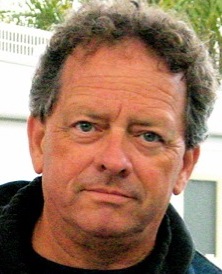Peggy's Progress
(Not to be confused with John Bunyan's tale of agony and doom!)

Michael is fond of saying "If only people would just listen to me and do what I say they'd be so much better off." At which point the recipient of these words of wisdom usually proceeds to roll their eyes and chuckle.
 At a family wedding last weekend, however, I detected something more than the customary "Oh, yeah, sure Uncle Michael" response. More and more now though, I see the younger generation is really starting to listen and pay attention. There is now a distinct and fully expressed appreciation among some of the younger Reddells who acknowledge that old Uncle Michael just might know what he's talking about after all. I say "old" only because he is now something of the clan elder since his Father passed away last year. At least two of the 20 and 30-somethings remarked to me at last week's wedding, how they are encouraged and inspired to watch Michael going for it or "finding his voice" as one put it. They now see Michael as an artist in full bloom and he's not just telling them to live their dreams, he's showing them the way to live a life they love. They can all see with their own eyes how much of a difference this has made in his life now that he is following his heart into art.
At a family wedding last weekend, however, I detected something more than the customary "Oh, yeah, sure Uncle Michael" response. More and more now though, I see the younger generation is really starting to listen and pay attention. There is now a distinct and fully expressed appreciation among some of the younger Reddells who acknowledge that old Uncle Michael just might know what he's talking about after all. I say "old" only because he is now something of the clan elder since his Father passed away last year. At least two of the 20 and 30-somethings remarked to me at last week's wedding, how they are encouraged and inspired to watch Michael going for it or "finding his voice" as one put it. They now see Michael as an artist in full bloom and he's not just telling them to live their dreams, he's showing them the way to live a life they love. They can all see with their own eyes how much of a difference this has made in his life now that he is following his heart into art.
I think there are some unspoken lessons and messages being passed on to the next generation and some are probably worth paying attention to at any age or stage of life:
-
If you have a passion for something do it. Real passion, whether it be for art or music or sports doesn't go away. It's always there inside you and generally isn't content to sit back quietly. The passion is deep in your core and even if you have to do your art or whatever part-time and on the side, just do it. It won't really settle for being stuffed down anyway so just don't give up on it and wait till you're retired and too tired to do it. If you don't feed that passion and give it some exercise every now and then you'll get pretty cranky and make those around you cranky too. Michael tried to set art aside for years and worked as a technical writer writing things that few understood or cared about (to put it bluntly) and though it paid well, there wasn't much joy in it.
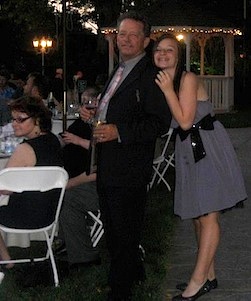
- Being an artist is clearly a labor of love because we certainly aren't in it for the money. Artists are more like ranchers or teachers who work long and hard at a their labor of love, because they aren't in it for the money either. And speaking of a labor of love, it's now Saturday night and we just got home from an all day Festival of Arts in Paso Robles. We're exhausted from a long day sitting at an exhibit booth talking to hundreds of people at an outdoor art festival. But it's great fun to show off Michael's work, and talk to people interested in what he's made and to hear peoples' ooh and ahhhs and say things like, "oh it's so wonderful and weird," or "lovely work," or "it's so interesting." Michael has spent the last several weeks laboring first over the second Phantom Project art show and more recently to prepare for today's art festival. He's had many late nights and long days of making art, getting The Phantom show hung and open, and yet it is totally different than years ago when he was stressed out about a work deadline at IBM. The stress really isn't as stressful when it's deadlines of your own choosing for things you are really inspired about. It's like Chris and Will who Michael talked about last week and how incredibly busy they are, but there is so much joy when they talk about what they are doing. Granted, they juggle dozens of projects and activities simultaneously but it's all a labor of love which breeds joy and not dread.
- And like ranching and teaching, art is not only a job but it's a way of life. Being an artist means you may not always have a lot of money but there are other compensations. Being surrounded by all kinds of artists, both exhibiting and visiting at the festival today just reaffirms this notion. I was talking to Peg Grady this afternoon congratulating her on the fact that she recently got two pieces into a show in Brooklyn, New York. I asked if she was going to be able to go see the show and she said it wasn't in the budget and that it's one of the few times she wishes she was rich. She says she hardly ever gets the feeling that she'd like to be rich but being able to see her own work in a distant show would be awfully fun. But on the whole, she's happy as a clam. Later Michael and I had the pleasure of meeting Andreanna Iakovidis, an artist from Santa Monica who was having a gallery opening tonight just up the street from the art festival. Andreanna paints incredibly beautiful pieces of chinoiserie and while we were all commiserating about the fact that it's hard to make a living as an artist, she said but "of course we do it because it makes us happy." No argument on that point.
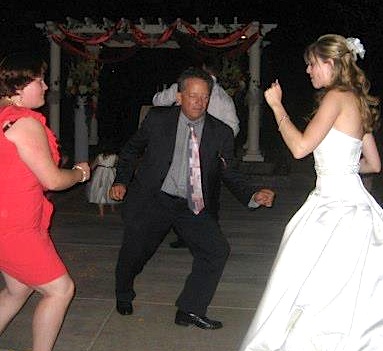
- The other thing about jobs is to realize that if you're not following your heart you're working for someone else's dream not your own. As Michael has tried to impress upon anyone in the family who would listen, if you're going to work hard you might as well work hard for yourself and your passion and not someone else's idea of what's important. A number of offspring and nephews and nieces have reached a transition point in their lives of what's next. They're pretty much done with school and now they need to decide which path to take so they've heard a lot from us about listening to themselves and choosing work that really means something to them. At the same time we all realize that sometimes you just have to pay the bills, especially in this economy where a job, any job is a precious thing. And at various points in our lives we all need to keep a job just to stay afloat. Our word to the wise on this point is to remind them that a job doesn't define us and shouldn't limit how we see ourselves or live in the world. Our job isn't who we are. It just helps us be who we are and want to be. It's really important not to lose site of that.
So you may be rolling your eyes by now too, but these lessons learned from Uncle Michael and Aunt Peggy have a lot of truth to them. So again as Michael says, "Pay attention people!"
Street Level
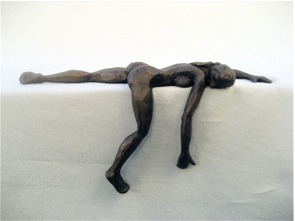
Yesterday, Peggy and I hung out all day at the downtown park in Paso Robles tending to our display at the juried Paso Robles Festival of the Arts. This was a first for us. I have never before been a participating artist in an outdoor art fair. I was dubious about whether this would be a fruitful sales experience.
I talked to countless passersby at the festival, and learned a lot about people's reactions to the art I had on display, and what those reactions mean.
For the past several years, art sales have been meager. I have attributed that to the woeful economy. And in response to that perception, I have made some adjustments. First, I scaled down the size of the work I was doing in order to lower prices and make the art more accessible. Next I pioneered my own process to cast pewter, and to eliminate my dependency on bronze foundries to complete the work. Most recently, I have begun working with alternative media to further reduce costs and drive prices even lower. The net effect of all these austerity measures was that at this art fair I had samples of work in bronze, pewter, and epoxy resin clay. Several of these works were only different in the material they were made from. I have found that I can pack wax molds with this epoxy resin clay and make remarkably good representations of the same work that I would normally produce in pewter or bronze.
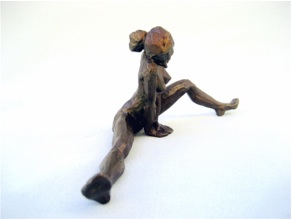
For yesterday's art fair, I displayed several essentially identical pieces with similar finishes where one was bronze and the other was epoxy resin clay. The process of making the resin pieces is dramatically simpler and cheaper to do than pouring bronze, and I priced the work accordingly. I wanted to see if people who would not pay $600 for a small bronze figure would buy the same item in epoxy resin for $100. This was a logical expectation if price were the critical variable. And I thought that I would in fact sell some of the low priced items.
I was enlightened and a bit surprised that not a single person bought anything. People flocked to our table enthusiastically to look at the work, to talk about it, and to get acquainted. They would look at the pieces and ask the prices. As I explained the difference in the materials, and the effect they had on cost, I discovered something interesting. People did not generally know the epoxy resin pieces were not bronze until I explained it to them and let them feel the difference in the weight of the items. But when they understood the price/material dynamic, they consistently rejected the cheaper items. Time after time, people took my card and said they would save up for the bronze. Some were clearly enamoured with a specific piece and seemed to genuinely be struggling with the temptation to buy the less expensive version. But time after time, they said, "No, I have to wait until I can get the bronze."
I learned from this that chasing the economy market in art simply doesn't work. On a limited budget, potential buyers will wait before they will compromise. This might have been due in part to the fact that I made the comparison of the real bronze and the bronze-like items so easy. If I had only presented the epoxy resin clay items, would that have reduced the resistance level? Was I sabotaging my efforts to sell "recession bronze" by comparing it so obiously with real bronze? Maybe. But regardless, the drastic reduction in price did not have any positive effect on buyers.
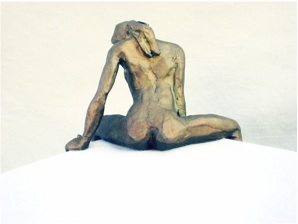
I also reinforced my perception that lots of people are really intrigued and inspired by my work. I know that people are not obliged to veer off the sidewalk suddenly to heap praise on the merits of any of the artwork they see. They can—and often do—simply walk by without comment. I got lots of really lavish admiration for the work yesterday. That was good for me. It can be hard to go on in the path you have chose if people do not respond to it. Those responses must be secondary or you will end up chasing approval rather than following your calling. But now and then, it's good for your energy level, clarity, and focus, to have an event like this where strangers go out of their way to express their pleasure about your work and wish you well.
It will take a few days, or perhaps longer, to assimilate what I learned from this experience. But one thing I know for sure is that the feedback from such an event is layered and textured and packed with significance. If you are not out there sharing your art at street level, I highly recommend that you try it.
|


 At a family wedding last weekend, however, I detected something more than the customary "Oh, yeah, sure Uncle Michael" response. More and more now though, I see the younger generation is really starting to listen and pay attention. There is now a distinct and fully expressed appreciation among some of the younger Reddells who acknowledge that old Uncle Michael just might know what he's talking about after all. I say "old" only because he is now something of the clan elder since his Father passed away last year. At least two of the 20 and 30-somethings remarked to me at last week's wedding, how they are encouraged and inspired to watch Michael going for it or "finding his voice" as one put it. They now see Michael as an artist in full bloom and he's not just telling them to live their dreams, he's showing them the way to live a life they love. They can all see with their own eyes how much of a difference this has made in his life now that he is following his heart into art.
At a family wedding last weekend, however, I detected something more than the customary "Oh, yeah, sure Uncle Michael" response. More and more now though, I see the younger generation is really starting to listen and pay attention. There is now a distinct and fully expressed appreciation among some of the younger Reddells who acknowledge that old Uncle Michael just might know what he's talking about after all. I say "old" only because he is now something of the clan elder since his Father passed away last year. At least two of the 20 and 30-somethings remarked to me at last week's wedding, how they are encouraged and inspired to watch Michael going for it or "finding his voice" as one put it. They now see Michael as an artist in full bloom and he's not just telling them to live their dreams, he's showing them the way to live a life they love. They can all see with their own eyes how much of a difference this has made in his life now that he is following his heart into art.





